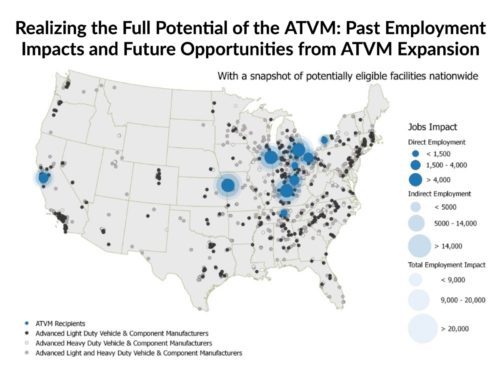WONK WEDNESDAY: Building the Electric Vehicle Fleet of the Future Here (Part Two: “The Nitty Gritty”)

The following post is authored by Reem Rayef, BlueGreen Alliance Policy Advisor.
See Part One of this blog series here.
URGENT POLICY PRIORITIES FOR SUPPORTING EV MANUFACTURING JOBS IN THE U.S.
The economic and environmental success of the nationwide transition to cleaner vehicles hinge on the extent to which decision-makers prioritize domestic EV manufacturing and good jobs as a part of a robust EV policy agenda, and a broader clean transportation agenda.
We need to put the pedal to the metal. Congress has already made a significant start, supporting a number of policies that strengthen advanced and electric vehicle manufacturing, and build good jobs in the auto sector, including several that have long been key BGA priorities. Policymakers have championed legislation that would expand the scope of the Department of Energy’s Advanced Technology Vehicles Manufacturing loan program (ATVM), convert and retool at-risk facilities through Section 132 Manufacturing Conversion & Industrial Retooling Grants, provide tax incentives for small & medium-sized automotive supply chain manufacturers via the Section 48C Tax Credit. They have also introduced legislation that would update key consumer incentives for EVs, electrify federal fleets, and expand the national EV charging network, all with an eye toward supporting domestic manufacturing and high quality jobs and prioritizing underserved communities.
Congress must build upon these measures to craft a comprehensive EV manufacturing investment, as a key piece of an effective recovery package. Below we describe key elements of such an investment:
Deploy $5B to enable at least $20B in loans through the ATVM
The ATVM plays a key role in spurring major auto and component manufacturers to locate their advanced vehicle and technology facilities in the US, rather than abroad, reducing risk as technology and markets shift. The ATVM has supported the establishment, retooling or expansion of 17 domestic auto manufacturing facilities in eight states to build clean, fuel-efficient, and electric vehicles. The policy has sustained or created at least 35,000 direct jobs, and 200,ooo indirect jobs. As the market accelerates toward EVs, the ATVM can again provide instrumental support for auto and manufacturing jobs throughout the supply chain, while facilitating vehicle emission reductions. Congress should at minimum replace the portion of ATVM funding rescinded in 2020, and expand the scope of the program to include medium & heavy duty vehicle and component manufacture, the manufacture of related electric charging & hydrogen fueling equipment, and other economically critical materials and technologies, which represent the key frontiers of advanced vehicle innovation. The ATVM is a high-impact program that leverages $2-5B funding to enable tens of billions in manufacturing investment. The program models how centering manufacturing as an integral part of the nationwide fleet transition can yield wins for jobs and the climate. With additional funding, the program could be utilized to spur investment across even more of the advanced transportation market and value chain. The wide, and geographically dispersed impacts of past—and potentially, future—use of the program are illustrated below in Figure 2.
Invest $25B in EISA Section 132 Manufacturing Conversion/Industrial Retooling Grants
The closure of manufacturing facilities can have widespread and lasting economic impacts on manufacturing communities, while undermining valuable manufacturing capacity, networks, and workforce capabilities. Manufacturing conversion and industrial retooling grants mitigate against this community devastation and costly economic disruption by directing investment to refurbish and retool recently-closed or at-risk facilities in the auto manufacturing sector. Conversion and retooling grants can play a key role in bringing new technology into existing facilities, and maintaining supplier networks and workforces. This allows for expansion of the domestic EV manufacturing sector and enhancement of local jobs and community benefits, while avoiding—and in some cases, redressing—the harms of poor industrial policies of the past. These grants are key to an EV transition that puts workers and communities first.
Make a $20B investment (at minimum) in the Section 48C Advanced Manufacturing Tax Credit
The always-oversubscribed 48C tax credit program has provided funding to over 180 facilities—predominantly in small- and medium-sized manufacturing—to establish or expand domestic production of a wide range of clean energy and industrial products, including EV components and materials. By increasing funding for the tax credits (and/or comparable grants) Congress can provide the necessary funds to establish or retool facilities manufacturing batteries, semiconductors, inverters, motors, and facilities that recycle critical minerals. These tax credits should prioritize distressed communities, including those that have traditionally relied on the fossil fuel economy for their livelihoods.
Fill domestic EV supply chain gaps through strategic manufacturing investment and production tax credits, among other potential measures.
The recent global semiconductor technology shortage, and its impacts on the domestic auto sector, illustrate how our reliance on a limited number of foreign suppliers for critical components can threaten our economic security. For the growing EV market, the challenge is even greater; the U.S. lags behind its competitors in producing central propulsion system technologies. Through a new manufacturing investment tax credit (ITC) designed to fill economically critical supply chain gaps, Congress can provide key support to speed investment in establishing landmark production facilities, while a production tax credit (PTC) can aid in supporting the domestic scale-up of novel technology production. These investments will facilitate the national transition to EVs, protect and create high-quality jobs, build resilience and stability into the domestic EV supply chain, and ward off or reverse the offshoring of good jobs throughout the automotives supply chain.
Figure 2:
A Holistic EV Manufacturing Strategy for Workers and Communities
Direct manufacturing investments are just one part of ensuring that the transformation of the domestic auto industry works for U.S. manufacturing, economy and workers. As laid out in our backgrounder, leading in EV manufacturing and good job creation requires the confluence and careful implementation of key policies, which Congress and the administration can act on now. Here’s how:
- IMPLEMENT A COMPREHENSIVE MANUFACTURING STRATEGY: Coordinate industrial, tax, trade and energy policies to support manufacturing, and make rebuilding U.S. manufacturing a key element of national action on climate, infrastructure and economic recovery in order to secure good jobs and a prosperous and sustainable future for all.
- RETURN TO SMART VEHICLE STANDARDS: Restore U.S. leadership in auto innovation, and as an advanced vehicle market, through a return to strong clean vehicle standards developed with key stakeholders—including labor—at the table.
- EXPAND, RETOOL & CONVERT AMERICAN FACTORIES: Protect existing auto workers and communities in the EV transition through the provision of loans, grants, tax credits, and other public subsidies that retool at-risk manufacturing plants .
- FILL GAPS IN CRITICAL SUPPLY CHAINS: Secure and strengthen U.S. auto jobs, manufacturing, and economic security by investing to onshore production of essential elements of the automotive and EV supply chain—from semiconductors and battery cells to the responsible domestic production, reclamation, and recycling of critical materials.
- REINVEST IN MANUFACTURING COMMUNITIES: Support working people and communities through geographically-based investments that ensure impacted and low-income communities see the economic benefits of family-supporting manufacturing careers, and spur the conversion and growth of local businesses throughout the clean vehicle supply chain hand in hand with strong labor, environmental and community benefit standards,
- LEVERAGE INNOVATION TO BUILD WHAT WE INVENT: Enforce and protect the US advantage in basic research by ensuring that American innovation is brought to life in American manufacturing.
- TAKE A NEW APPROACH TO FAIR TRADE: Ensure our trade agreements and enforcement improve worker and environmental standards throughout the supply chain, and stem the shift of jobs and pollution overseas.
- MAKE EVS ACCESSIBLE TO ALL: Spur consumer demand for American-made EVs through incentives and charging infrastructure investments that make EV adoption the practical and affordable choice, particularly for drivers in underserved communities.
- ELECTRIFY PUBLICLY-OWNED VEHICLE FLEETS: Leverage public fleets to boost clean transportation options and stimulate demand through deployment of domestically manufactured electric transit buses, school buses, and USPS vehicles.
- LEAD BY EXAMPLE: Facilitate a fair transition to a clean transportation future by ensuring all public investments, including tax credits and procurements, are contingent upon high-quality environmental, labor, safety, domestic content, and community standards.
DRIVING TOWARD A JUST EV FUTURE FOR WORKERS AND COMMUNITIES
Just as direct manufacturing investments are only one part of ensuring we rebuild automotive manufacturing and jobs in the shift to EVs, this critical clean vehicle manufacturing strategy is just one part of ensuring a just and equitable clean transportation agenda. A truly comprehensive approach encompasses not only what happens in America’s plants and factories, but also the process by which cleaner vehicles become part of transformed transportation systems.
The Biden Administration has strongly advocated for a whole-of-government effort to build a clean transportation future. This includes not only EV deployment and infrastructure commitments, but also major investments in transformed transportation systems, such as including sorely-needed funding for public transit, support for clean, efficient and equitable freight and commercial transportation, and much more.
We agree. Vehicle decarbonization must be an integrated building block of a just and clean transportation future. Transportation policy priorities also must fully engage labor and communities—from policy design to implementation—in order to be both effective and equitable for working people across America. For more on our adjacent priorities, please see our blog on how pro-worker surface transportation policies can help achieve climate goals, and our broader agenda on clean technology manufacturing & industrial transformation.
